- News
- Reviews
- Bikes
- Accessories
- Accessories - misc
- Computer mounts
- Bags
- Bar ends
- Bike bags & cases
- Bottle cages
- Bottles
- Cameras
- Car racks
- Child seats
- Computers
- Glasses
- GPS units
- Helmets
- Lights - front
- Lights - rear
- Lights - sets
- Locks
- Mirrors
- Mudguards
- Racks
- Pumps & CO2 inflators
- Puncture kits
- Reflectives
- Smart watches
- Stands and racks
- Trailers
- Clothing
- Components
- Bar tape & grips
- Bottom brackets
- Brake & gear cables
- Brake & STI levers
- Brake pads & spares
- Brakes
- Cassettes & freewheels
- Chains
- Chainsets & chainrings
- Derailleurs - front
- Derailleurs - rear
- Forks
- Gear levers & shifters
- Groupsets
- Handlebars & extensions
- Headsets
- Hubs
- Inner tubes
- Pedals
- Quick releases & skewers
- Saddles
- Seatposts
- Stems
- Wheels
- Tyres
- Health, fitness and nutrition
- Tools and workshop
- Miscellaneous
- Buyers Guides
- Features
- Forum
- Recommends
- Podcast
review
£1,730.00
VERDICT:
Well featured frame and great component spec for the money makes the Xenith T an ideal first time trial bike.
Weight:
9,500g
Contact:
www.evanscycles.com
At road.cc every product is thoroughly tested for as long as it takes to get a proper insight into how well it works. Our reviewers are experienced cyclists that we trust to be objective. While we strive to ensure that opinions expressed are backed up by facts, reviews are by their nature an informed opinion, not a definitive verdict. We don't intentionally try to break anything (except locks) but we do try to look for weak points in any design. The overall score is not just an average of the other scores: it reflects both a product's function and value – with value determined by how a product compares with items of similar spec, quality, and price.
What the road.cc scores meanGood scores are more common than bad, because fortunately good products are more common than bad.
- Exceptional
- Excellent
- Very Good
- Good
- Quite good
- Average
- Not so good
- Poor
- Bad
- Appalling
The Xenith T is Jamis' entry level carbon time trial bike, constructed from medium modulus T700 fibres and coming equipped with a surprisingly good component spec. At a suggested retail price of £1730, the Xenith T promises real value for the aspiring time trialist or triathlete looking to up the ante and buy some free speed.
Frame & spec
Despite its entry-level billing, the Xenith T frame includes some pretty impressive features usually reserved for bikes many times the price, most notably, the hidden brakes both front and rear. The front brake is mounted on the rear of the fork and hidden from view by the 'aeroshield' fairings which extend rearwards from the deep section fork. The rear brake is mounted under the bottom bracket where the air is already 'dirty', leaving the seatstays to be shaped and positioned for minimum drag. All cable routing is internal except for the front brake which requires a few cable ties to tidy it up as it tends to hang out there in the wind.
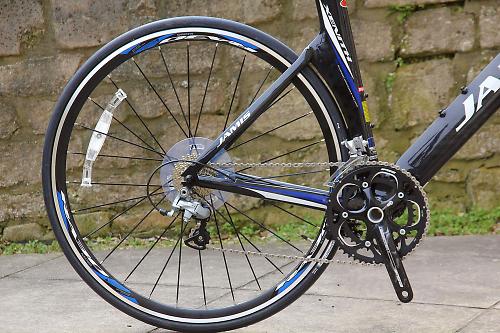
From an aerodynamic point of view, hidden brakes make a lot of sense, but the trade-off comes in terms of braking performance and serviceability. The Tektro linear pull brakes on the Xenith were pretty spongy right from the get go, and things didn't improve with time. The brake design coupled with the convoluted cable routing means that power is much lower that you would expect from a set of dual-pivot road callipers. Having said that, braking performance isn't all that high on the priority list for a time trial bike, especially if it comes at the expense of speed, and I never felt like the Xenith was dangerous during my time with it.
What I did find frustrating though was how difficult the brakes proved to adjust. Being tucked behind the bottom bracket, the rear driveside brake shoe was near impossible to adjust without first removing the chainset. The front brake was easier to adjust due to the two small access ports in the fork (covered over by rubber bungs when riding), but the problem here was the clearance on the pads when fitting wide wheels. It was only by angling the brake pads up at 45 degrees (not recommended) that I was able to fit a Reynolds Aero 58 front wheel that I was testing alongside the bike. This has a similar outside rim width to the Zipp Firecrests and new offerings from HED, Enve and Bontrager, so I'd expect similar issues with those.
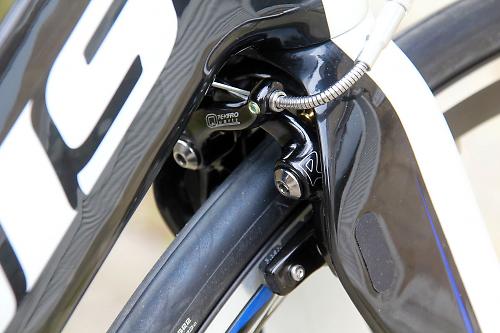
Brakes aside, the Xenith T is quite traditional in appearance with a deep aerofoil section downtube and seat tube connected by a slim, horizontal top tube which terminates in a neat integrated seatpost clamp. The steep 78 degree seat tube positions the rider well over the front of the bike and houses a proprietary carbon, teardrop-shaped seatpost. Whilst this aggressive geometry is ideal for triathletes or CTT time trials unencumbered by the UCI rules on bike position, smaller riders wanting to stick to the rules may struggle to achieve the required 5cm of setback because the single-position seat clamp limits fore-aft saddle adjustability. I had to move the saddle nearly all the way backwards on its rails and that's with a saddle height of 80.5cm.

The bottom bracket area is suitably tall and beefed up to house the PF30 bearings, and is paired with a set of FSA Gossamer cranks with 53x39 chainrings. Together with the 11-25 cassette, you've got some proper gears to get you started in time trials.
Moving to the rear of the bike, the Xenith T features horizontal dropouts with adjustable stops to enable you to position the wheel as closely as possible to the seat tube cutout. An additional benefit to this style of dropout is the ability to convert the bike to a fixed gear for velodrome use.

Most top end TT bikes nowadays feature integrated stem and aerobar arrangements but the Xenith makes do with a simple stem and straight 1 1/8in steerer setup.
While you might be giving up a few extra watts in drag, the system is easy to adjust for both height and length by either swapping spacers or changing stem lengths. The short headtube means that most riders will probably end up running a few spacers under the stem, but the option to go very low on the front end is still open to the more flexible.

Similarly, the Profile Design T2 aerobar is perhaps a little overshadowed in a world of sculpted carbon creations, but it features plenty of adjustability and can be set up to suit most arm positions, an important consideration when the majority of a rider's aero drag is down to their position on the bike. With a bit of tinkering, it was possible to get the extensions and pads positioned very narrow (forearms touching each other) for a super-aggressive position that cheaper aerobars can sometimes struggle to produce. All of the adjustment can be done with 5 and 6mm Allen keys so no specialised tools are needed.
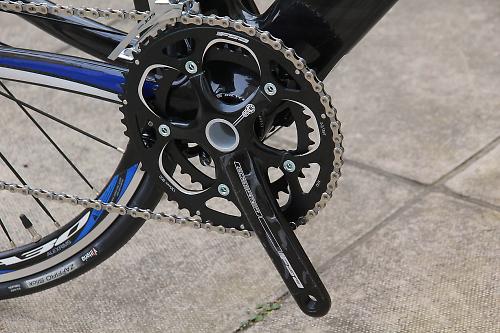
The Xenith T's drivetrain is composed of a rather eclectic mix of brands and components, with Shimano derailleurs and cassette, Microshift bar-end shifters and a Sram chain. Despite this, shifting was smooth and reliable throughout the entire testing period. The only real niggle I experienced was a tendency for the rear shifter to release some cable tension (thereby shifting into a harder gear) when hitting any potholes, which admittedly, isn't something that happens too often when riding a TT.

Wheels are often an area of cost-cutting in more budget oriented bikes and that's the case with the Xenith T too. The 30mm deep, aluminium Alex rims are paired to Formula hubs resulting in pretty heavy wheels which are a bit of a struggle to get up to speed. As a set of training wheels, they do all right and have proved reliable over a number of months, but you'll be wanting to upgrade rather soon to a set of deep sections or even a disc wheel for any actual racing.
The ride
Out on the road, the Xenith T proved to be very stable at speed and surprisingly smooth also, inspiring confidence to stay in the aerobars even when heading down fast descents and through flowing corners. For a novice TTer, the Xenith provides a great platform to get used to the more forward position afforded by a time trial bike.

Where the bike does suffer though is when accelerating up to speed. The use of medium modulus fibres in the frame (as opposed to higher modulus fibres on more expensive bikes) results in quite a bit of added weight which makes it feel sluggish and unresponsive in stop-start situations. The stiffness of such fibres is also lower and there is definitely a bit of 'give' in the frame when stomping on the pedals. It's not a noodle by any stretch of the imagination, but compared to a top-end bike, the difference is noticeable. However, time trials are a steady-state effort for the most part and once up to speed, the Xenith's weight becomes insignificant.
Evaluating the aerodynamics of a TT frame is difficult to do outside a controlled setting such as a wind tunnel or velodrome, even with a power meter such as I used. Is the Xenith slower than bikes costing twice the price? Probably a few watts here or there.
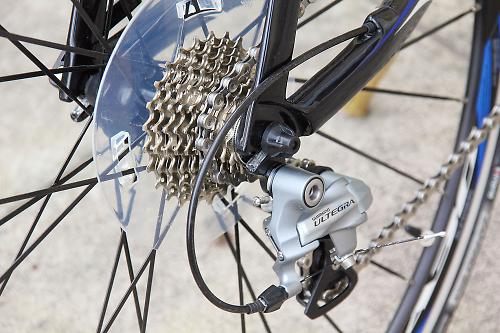
However, as an entry-level TT bike, the Xenith T isn't competing against the numerous superbikes out there, but against similarly priced road bikes with a set of clip-on aerobars attached. In this comparison, the Xenith does provide a noticeable speed advantage, mostly due to the specific geometry which enables the rider get to lower at the front without compromising power.
Verdict
Well featured frame and great component spec for the money makes the Xenith T an ideal first time trial bike, only let down a little by its heavy overall weight and fiddly-to-adjust brakes.
road.cc test report
Make and model: Jamis Xenith T Time Trial bike
Size tested: 54cm
About the bike
State the frame and fork material and method of construction. List the components used to build up the bike.
Frame: High performance carbon fiber composite with mid modulus fibers, Dyad Plus T700/FRP lay-up, Tri/TT frame, NACA compliant profiles, chainstay-mounted rear brake, internal cable routing, integrated seat post clamp design, seat tube with full rear wheel recess, flat-oval top tube, aerofoil seatstays, PressFit 30 BB shell, rear-entry horizontal dropouts with axle-position adjustment bolts
Fork: Windshield aero carbon with rear-facing/enclosed front brake for reduced aerodynamic drag, with brake pad adjustment ports
Headset: FSA Internal AheadSet, 1 1/8"
Wheels: Alex RA30 aero rim, 20/24H, 30mm aero rim profile, Formula alloy hubs with QR and Formula bladed stainless steel spokes
Tires: Vittoria Zaffiro Slick, 700x23c (Vittoria Rubino 650x23c for XS)
Derailleurs: Shimano 105 RD-5700 rear and 105 FD-5700 braze-on front
Shiftlevers: microSHIFT Bar End Shifters 20-Speed
Chain: SRAM PC1031 w/Powerlock
Cassette: Shimano 10-Speed 11-25T
Crankset: FSA Gossamer double with Press Fit 30, 53/39T, 170mm (XS/S), 172.5mm (M), 175mm (L/XL)
Bottom Bracket: FSA PressFit 30
Brakeset: Tektro R725 forged alloy hidden U-type TT calipers with SwissStop cartridge pads and Tektro TL-720 aero brake levers
Handlebar: Profile Design T2
Stem: Profile Design Aris, 3D forged 6061 alloy, 7° x 80mm (XS), 90mm (S/M), 100mm (L/XL)
Grips: Jamis gel suede tape with Jamis logo
Seat Post: Jamis Aero carbon post with integrated seat post clamp
Saddle: Selle San Marco ERA TT with Syntex + Kevlar cover and carbon steel rails
Sizes: XS (650c), S, M, L, XL
Color: Pure White/Gloss Carbon
Weight: 9.5kg
Tell us what the bike is for, and who it's aimed at. What do the manufacturers say about it? How does that compare to your own feelings about the bike?
According to Jamis, the Xenith T has been designed to "squeeze every bit of speed from every milliwatt you can muster against the clock". Blimey.
Frame and fork
Overall rating for frame and fork
7/10
Tell us about the build quality and finish of the frame and fork?
No visible defects on the paint or the underlying carbon.
Tell us about the materials used in the frame and fork?
The frame is constructed from T700 mid-modulus carbon and the fork is carbon too.
Tell us about the geometry of the frame and fork?
A full run-down of sizes and geometry is available on the Jamis website. Highlights include a 78 degree seat tube angle (common across all sizes) and a 72 degree head tube angle (except the small size which is 71 degrees).
How was the bike in terms of height and reach? How did it compare to other bikes of the same stated size?
The reach is pretty standard for a time trial bike and matches up well to the equivalent sized road bike. ie. if you're on a 56cm road bike then the Large size should fit you.
The short head tube means that frame stack is low so a couple of spacers will be necessary for most.
Riding the bike
Was the bike comfortable to ride? Tell us how you felt about the ride quality.
For a time trial bike, the Xenith T didn't feel overly harsh. I was able to complete a 85 mile ride of the bike without feeling beaten up at the end.
Did the bike feel stiff in the right places? Did any part of the bike feel too stiff or too flexible?
Compared to a top-end road bike, the Xenith T felt a little soft in the bottom bracket area and just didn't have quite the same acceleration when stomping on the pedals. Up front, the straight 1 1/8" steerer means that steering isn't quite as razor sharp as with tapered models, but for time trial purposes I found is adequate.
How did the bike transfer power? Did it feel efficient?
There was noticeable flex when sprinting or accelerating, but otherwise the Xenith T was able to hold its speed well.
Was there any toe-clip overlap with the front wheel? If so, was it a problem?
No.
How would you describe the steering? Was it lively, neutral or unresponsive? Stable
Tell us some more about the handling. How did the bike feel overall? Did it do particular things well or badly?
The bike inspired confidence to stay in the aerobars, even over rough ground. For a first time TT bike, the Xenith is ideal.
Which components had the most effect (good or bad) on the bike's comfort? would you recommend any changes?
The Selle San Marco saddle is TT specific and includes plenty of padding in the nose. That said, I didn't find it particularly comfortable and would definitely be looking to swap in the future.
Which components had the most effect (good or bad) on the bike's stiffness? would you recommend any changes?
The stiffness (or lack of) can be mostly attributed to the frame. Past experiences with both the FSA Gossamer cranks and the Profile Designs T2 bars have shown them both to be plenty stiff.
Which components had the most effect (good or bad) on the bike's efficiency? would you recommend any changes?
The hidden brakes and other aero optimized features ensure that the Xenith holds it speed well as you would expect from a TT bike.
Rate the bike for efficiency of power transfer:
6/10
Frame didn't feel as stiff as some.
Rate the bike for acceleration:
5/10
Heavy wheels and overall weight lets it down in this area.
Rate the bike for sprinting:
5/10
Again, the stiffness lets it down.
Rate the bike for high speed stability:
8/10
Confidence inspiring when up to speed.
Rate the bike for cruising speed stability:
8/10
See above. Cruising speed is high speed on a TT bike.
Rate the bike for low speed stability:
7/10
No issues when navigating traffic.
Rate the bike for flat cornering:
7/10
Rate the bike for cornering on descents:
7/10
Rate the bike for climbing:
6/10
Weight and forward position affect climbing ability.
The drivetrain
Rate the drivetrain for performance:
8/10
A few issues with miss shifts from the shifters.
Rate the drivetrain for durability:
8/10
Rate the drivetrain for weight:
7/10
Rate the drivetrain for value:
9/10
Wheels and tyres
Rate the wheels and tyres for performance:
5/10
Heavy wheels and the tyres aren't the best in the wet.
Rate the wheels and tyres for durability:
7/10
So far so good after 4 months of testing.
Rate the wheels and tyres for weight:
5/10
Heavy
Rate the wheels and tyres for comfort:
6/10
Rate the wheels and tyres for value:
6/10
Definitely the area in which costs have been cut.
Controls
Rate the controls for performance:
6/10
A few issues with miss shifts from the shifters and the brakes felt vague.
Rate the controls for durability:
8/10
No issues.
Rate the controls for weight:
7/10
Rate the controls for comfort:
7/10
Rate the controls for value:
7/10
Your summary
Did you enjoy riding the bike? Yes.
Would you consider buying the bike? Yes.
Would you recommend the bike to a friend? Yes.
Rate the bike overall for performance:
7/10
Rate the bike overall for value:
8/10
About the tester
Age: 22 Height: 190cm Weight: 69kg
I usually ride: Canondale EVO Red My best bike is:
I've been riding for: Under 5 years I ride: Every day I would class myself as: Semi pro
I regularly do the following types of riding: road racing, time trialling, cyclo cross, commuting, mtb,
For 5 years, racing was my life and I went all the way from a newbie bonking after 40 miles, to a full-timer plying my trade on the Belgian kermesse scene. Unfortunately, the pro dream wasn't meant to be and these days, you're more likely to find me bimbling about country lanes and sleeping in a bush on the side of the road.
Latest Comments
- ktache 5 min 46 sec ago
I have a fair bit of trust in Rene Herse, they seem to go for quality and performance. Shame if this product doesn't match my impressions....
- BalladOfStruth 22 min 55 sec ago
+1 on this. In my experience, driving professionally tends to bring complacency and arrogance over competence. I've had far more issues/run-ins...
- chrisonabike 1 hour 36 min ago
Indeed - but it's no more inconsistent than our current road design - very often UK high streets are "for shopping" and also a busy through route....
- chrisonabike 2 hours 13 min ago
People who are subsidised* to make big holes in road (amongst other negative effects) complain about the holes in the road. Same people also...
- mike the bike 3 hours 7 min ago
If you ask the world's leading economic commentators how many people have been rescued from abject poverty by capitalism the average answer would...
- The Larger Cyclist 3 hours 31 min ago
loads of parking
- brooksby 4 hours 15 min ago
I hate it when I can't find the obvious source of a puncture.
- don simon fbpe 6 hours 19 min ago
Now, if we're talking gravel bikes, that's a whole different story. Gimme, gimme, gimme! Apologies for the Facebook link....
- wtjs 6 hours 22 min ago
The police are operationally independent, in fact the regional Police and Crime Commissioners have to swear in their oath of office that they will...























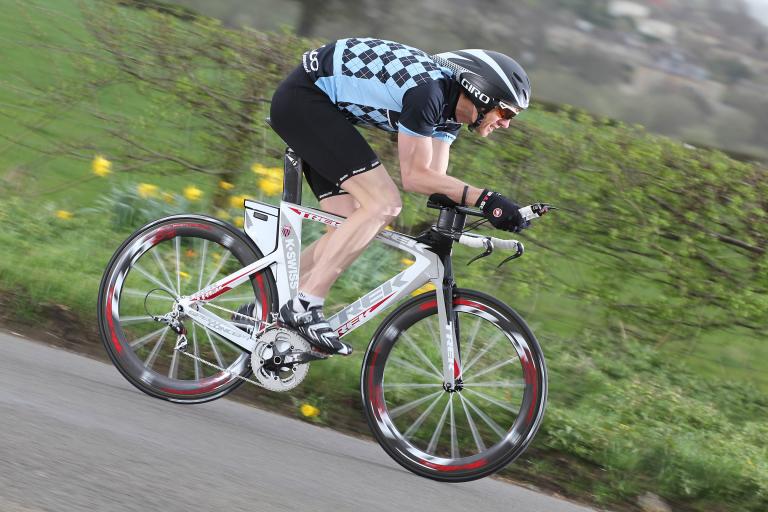
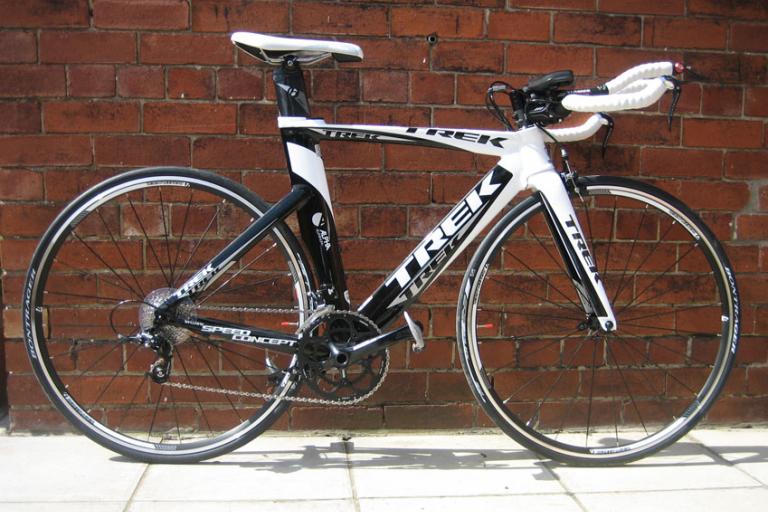
Add new comment
9 comments
Nor me, I would wait and save the extra £270 needed for the Planet X Exocet 2 with Dura Ace
Doesn't seem like good value to me at all
and gossamer cranks and zaffiro tyres at £1700?
no no leave them on it helps detract from the sheer ugliness of this bike.
this article should have some kind of health warming
I do think for all further review pictures road.cc should remove the plastic piece of junk between the wheel and the cassette and remove the wheel reflectors
It was the fork that was the problem, not the brakes when it came to fitting wide rims. The front of the brake shoe contacted the fork before it could move out far enough to clear the rim. Sorry if I didn't make it clear in the review.
(Notwithstanding, they're a b*tch to work on!)
The Tektro/TRP brakes are designed to accept wide rims by removing the large washer from between the pad and the brake arm. (At least, this is certainly the case for the TRP model I have, and is specifically noted in the product literature, I would imagine it is the same for the R725.)
????
!!!
???